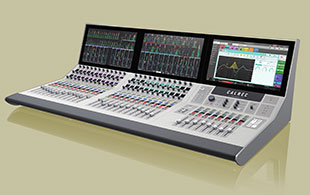Following a clash of names, Calrec Audio has rechristened its Callisto audio console Summa.
 The console is designed for broadcast applications requiring more modest faciltites than those offered by Calrec’s Apollo and Artemis consoles. ‘We took the decision to change the name because Callisto was recently registered by another pro audio company – we missed the registration, and were consequently asked to change it, which of course we have agreed to do,’ says Henry Goodman, Calrec Head of Sales & Marketing. ‘The term Summa is mainly used for texts that “sum up” knowledge in a field, and the name also reflects the fact that a mixing console is essentially a summing engine.
The console is designed for broadcast applications requiring more modest faciltites than those offered by Calrec’s Apollo and Artemis consoles. ‘We took the decision to change the name because Callisto was recently registered by another pro audio company – we missed the registration, and were consequently asked to change it, which of course we have agreed to do,’ says Henry Goodman, Calrec Head of Sales & Marketing. ‘The term Summa is mainly used for texts that “sum up” knowledge in a field, and the name also reflects the fact that a mixing console is essentially a summing engine.
Designed to offer intuitive operation in live broadcast, Summa simplifies complex workflow tasks through an intuitive GUI that is suited to a broad range of operator levels. Control is via a 17-inch multitouch screen inspired by tablet technology. The high-resolution display provides control and clear presentation of information. Additional displays are fully configurable to display bus, output and loudness meters, and feature dedicated metering, routing and processing information per fader.
The physical control surface is available in fixed 20-, 32- and 44-fader configurations with a streamlined layout. Each channel strip has only the most essential mechanical controls, featuring a fader, two flexible control cells, and a dedicated gain pot.
The console uses Calrec’s Bluefin2 technology at its core, and the same integral Hydra2 technology as the Apollo and Artemis consoles. Bluefin2 provides Summa with a pool of 180 channel processing paths, which can be assigned as mono, stereo, or 5.1 channels. Because there is no resource-sharing across the DSP, all facilities are available on all channels at all times. Summa has eight groups, four mains (all of which can be mono, stereo or 5.1), 16 auxes, and 32 tracks. The broadcast-focused feature set also includes complete system redundancy, dedicated delay on all paths with additional assignable input and output delay, mechanical PFL overpress on all faders, and three 5.1 studio monitor outputs.
More: www.calrec.com













